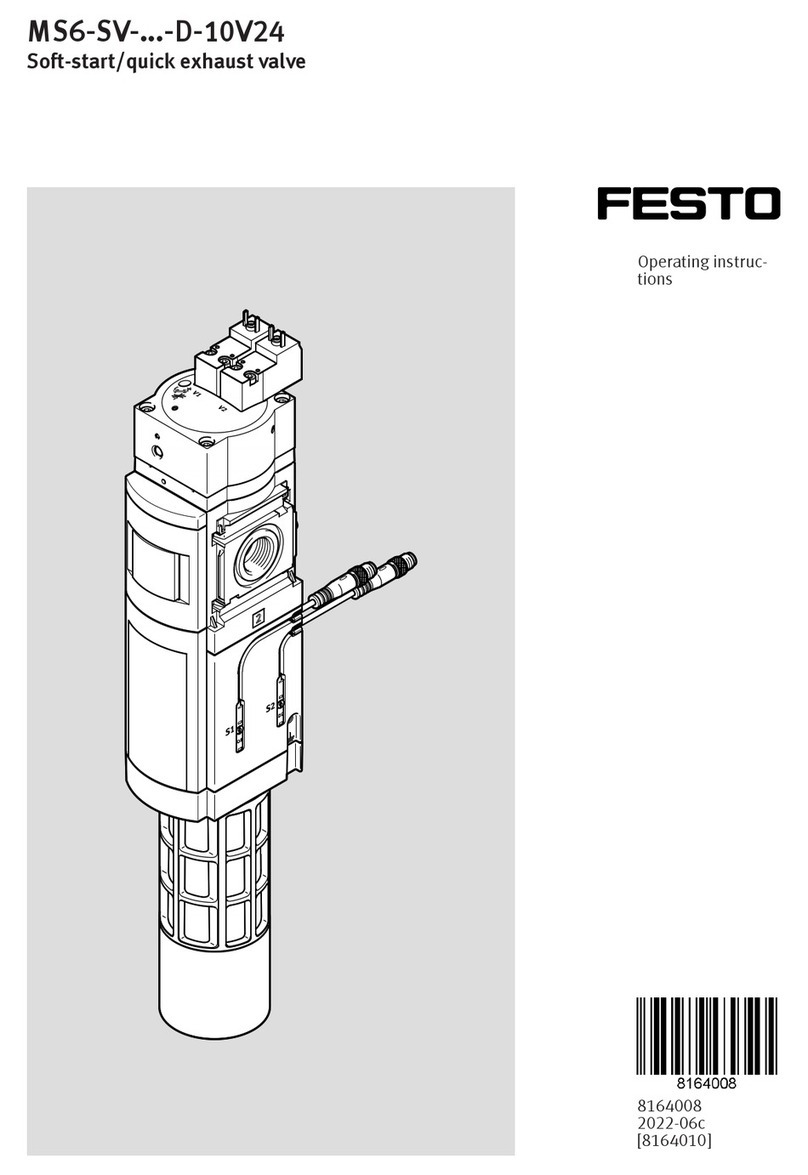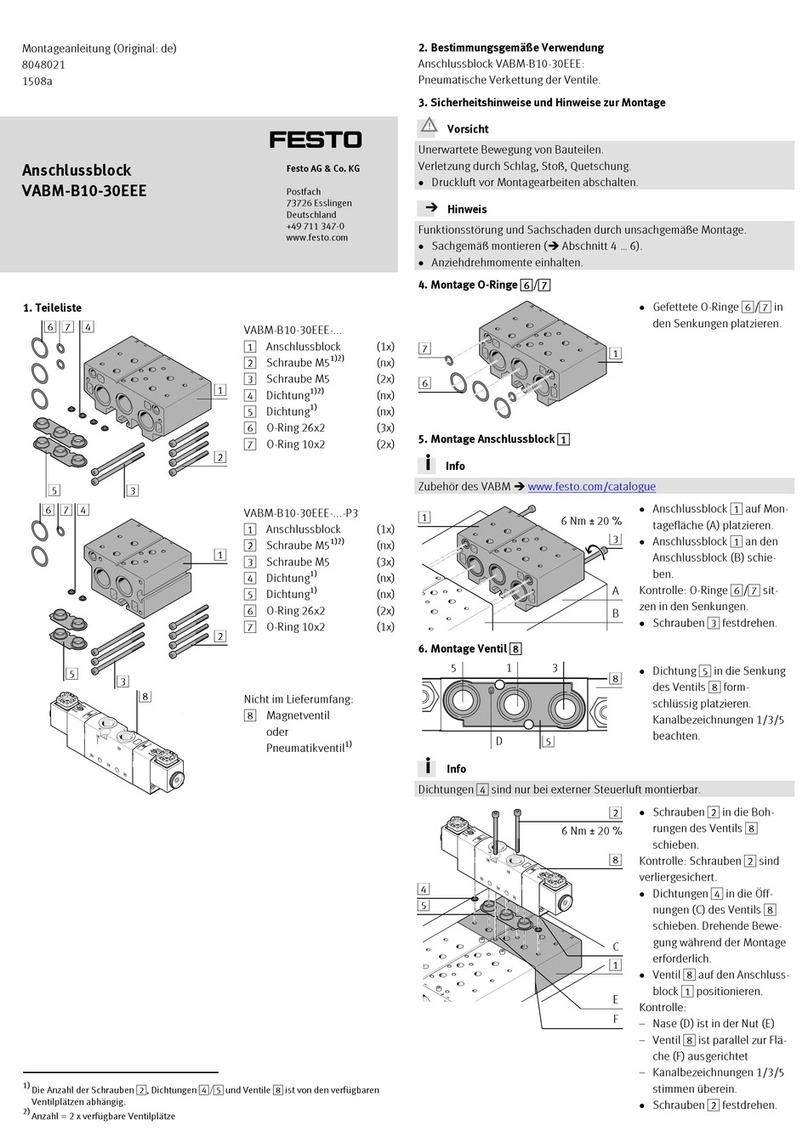Festo DFST-32 G2 Series User manual

Translation of the original instructions
© 2020 all rights reserved to Festo SE & Co. KG
1 Applicable Documents
All available documents for the product èwww.festo.com/sp.
2 Safety
2.1 Safety instructions
– Take into consideration the ambient conditions at the location of use.
– Only use the product in original status without unauthorised modifications.
– Observe labelling on the product.
– Store the product in a cool, dry, UV-protected and corrosion-protected envir-
onment. Ensure that storage times are kept to a minimum.
– Prior to mounting, installation and maintenance work: Switch off compressed
air supply and secure it from being switched back on.
– Observe tightening torques. Unless otherwise specified, the tolerance
is±20%.
2.2 Intended Use
The stopper cylinder DFST is designed for use as a retractable fixed stop in order
to reach defined holding positions with transported material (e.g. on mounting or
sorting systems). The DFST sorts the stationary transported material in buffer
zones.
Fig. 1 Stopping transported material
2.3 Foreseeable misuse
With DFST-...-L: the toggle lever must not be overrun in the stop direction by the
transported material when the lever locking mechanism is active. Otherwise the
transported material will damage the locking mechanism.
2.4 Training of qualified personnel
Installation, commissioning, maintenance and disassembly should only be con-
ducted by qualified personnel.
The skilled personnel must be familiar with the installation of pneumatic control
systems.
3 Further information
– Accessories èwww.festo.com/catalogue.
– Spare parts èwww.festo.com/spareparts.
4 Service
Contact your regional Festo contact person if you have technical questions
èwww.festo.com.
5 Product overview
5.1 Function
The stopper cylinder DFST is a double-acting cylinder. The piston rod is extended
with the toggle lever mechanism by pressurising the supply port 1. The toggle
lever gently stops the incoming transported material with the integrated shock
absorber. The piston rod is retracted by pressurising the supply port 2. The
stopper cylinder with spring return (not applicable for DFST-...-D/DL) can also be
set to single-acting. This is done by screwing a silencer into the supply port 1.
This makes sense if reduced extension velocities are sufficient.
Lever Locking Mechanism
With the stopper cylinder DFST-..-L with a factory-installed lever locking mechan-
ism, the toggle lever locks into its end position. When the stopper cylinder is
retracted, the toggle lever locking mechanism is automatically deactivated.
5.2 Structure
1Supply port (extending, 2x)
2Supply port (retracting, 2x)
3Guide rod for protection against
rotation
4Piston rod
5Detent for knurled nut
6Roller toggle lever
7Stop roller
8Thread for inductive proximity
sensor (2x)
9Lever locking mechanism (option-
al)
10 Knurled nut for setting the cush-
ioning
11 Stop for lever locking mechanism
12 Hole for mounting toggle lever
deactivation mechanism
13 Through-hole for mounting (4x)
14 Slot for proximity sensor (6x)
Fig. 2 Product design
8123248
DFST-32-...-G2
Stopper cylinder
8123248
2020-01
[8123250]
Instructions| Operating
Festo SE & Co. KG
Ruiter Straße 82
73734 Esslingen
Germany
+49 711 347-0
www.festo.com

6 Mounting
6.1 Preparation
Fig. 3 Maintain required distances
• Leave sufficient space for the pneumatic connections and for replacing the
shock absorber.
Fig. 4 Alignment of transported material
• Observe the following points:
– the conveyed material impinges on the roller of the toggle lever.
– the direction of transport of the transported material is exactly perpendic-
ular to the roller toggle lever.
Fig. 5 Changing stopper head
• The roller toggle lever 9can be rotated 90° to each of 4positions by the off-
set of the guide rod. Lock guide rod with thread-locking compound when
screwing it into the new position.
Fig. 6 Mounting Clearances
• Observe distances X1, X2 and X3. The distances refer to the bottom of the
flange as the mounting level of the stopper cylinder with the piston rod exten-
ded.
Size 32
X1 (maximum distance from the bottom of the pallet) [mm] 76.1
X2 (toggle lever pressed) [mm] 81.3
Size 32
X3 (minimum distance from the bottom of the pallet) [mm] 73.81)
1) The dimensions refer to the position of the maximum energy absorption (knurled nut in the upper posi-
tion).
Tab. 1 Mounting Clearances
6.2 Mounting
Fig. 7 Direct mounting
• Fasten the stopper cylinder with 4 screws.
Size 32
Screw M6
Tab. 2 Screw Sizes
6.3 Mounting Accessories
Proximity Sensor
Fig. 8
• Fasten the proximity sensor in the thread 8 or in the slot aD in accordance
with the assembly instructions.
Lever Deactivating Mechanism
Fig. 9 Lever Deactivating Mechanism
• Attach the lever deactivating mechanism in accordance with the assembly
instructions.
7 Pneumatic installation
• Select one of the two alternative connections:

AConnection on flange BConnection from below
Fig. 10 Alternative pneumatic ports
• Select one of the two actuation types (single-acting/double-acting):
2Retracting connection 1Extending connection
Fig. 11 Double-acting actuation
2Retracting connection SSilencer
Fig. 12 Single-acting actuation
1. When used as a single-acting cylinder: screw a silencer into the supply port
on the bottom (èwww.festo.com/catalogue).
2. Connect hoses to supply ports.
If necessary, convert and seal threaded pins in the alternative connections.
8 Commissioning
WARNING!
Risk of injury due to unexpected movement of components.
• Protect the positioning range from unwanted intervention.
• Keep foreign objects out of the positioning range.
1. Pressurise the system slowly.
2. Start test run:
Double-acting insert Single-acting insert Reaction
Pressurise1 supply port. Exhaust2 supply port. The piston rod extends.
Start stopper cylinder with transported material. The moving transported
material is stopped and
presses the toggle lever to the
rear end position (with the
DFST-...-L variant this locks
the toggle lever).
Pressurise2 supply port and
exhaust supply1 port.
Pressurise2 supply port. The piston rod retracts. The
lever deactivating mechanism
is released. The transported
materials is moved on.
Pressurise1 supply port and
exhaust supply2 port.
Exhaust2 supply port. Piston rod extends. The stop-
per cylinder can stop the next
batch of transported material.
Tab. 3 Commissioning Steps
3. Finish test run after completing all settings.
Automatic Unlocking of the Lever Locking Mechanism with DFST-...-L (Accessor-
ies)
Fig. 13
• Pressurise2 supply port.
ÄWhen the piston rod is retracted, it presses the lever locking mechanism
on the screw and releases the toggle lever.
Cushioning Setting
Fig. 14 Adjust shock absorber
1. Loosen the detent for the knurled nut 5.
2. Turn knurled nut until the desired cushioning is reached.
ÄWhen the setting is correct, the transported material presses the toggle
lever quickly and stops. The cushioning is too hard if the transported
material springs back immediately or requires a long time to press the
toggle lever down completely. The cushioning is too soft if the toggle
lever hits the end position hard without any visible damping.
The setting range has an upper and a lower stop:
– Turn knurled nut aJ anticlockwise in the "+" direction: cushioning
becomes harder
– Turn knurled nut aJ clockwise in the "-" direction: cushioning
becomes softer
3. Tighten the detent for the knurled nut 5. Tightening torque: 1.5 Nm
9 Maintenance
9.1 Cleaning
Clean the outside of the product with a soft cloth. Do not use aggressive cleaning
agents.

9.2 Lubrication
• After every cleaning grease the following components with LUB-KC1
èwww.festo.com/spareparts:
15 Bolt of the stop roller
16 Bolt of the toggle lever
4Piston rod
3Guide rod for protection against
rotation
17 Grease thrust bolt on the front side
Fig. 15 Lubrication points
• With DFST-...-L with lever locking mechanism: also grease all bearing points
of the moving parts.
9.3 Fault Clearance
Malfunction Possible cause Remedy
Wear on one side of
the guide rod
Transported material
impacts diagonally on
the toggle lever
Align stopper cylinder in the direction of trans-
port, transported material must meet the toggle
lever vertically.
Cushioning incorrectly
set
Correct cushioning
Conveyor speed too
high
Reduce velocity
Hard impact on the
toggle lever
Shock absorber faulty Replace shock absorber
(èspare parts catalogue, www.festo.com)
Tubing connection
error
Check blanking plug
Check tubing connection
Piston rod in initial
position despite pres-
surisation Reduced flow rate
through elbow con-
nectors
Avoid elbow connectors
Cushioning incorrectly
set
Correct cushioning Toggle lever does not
reach end position
Transported material
load (push-through
force) too low
– Increase load
– Increase coefficient of friction between con-
veyor and material
– Increase slope of conveyor
Tab. 4 Fault Clearance
9.4 Repair
WARNING!
Risk of injury caused by ejected components.
Springs under tension and compressed air eject the piston cap outwards when
demounting the retaining ring.
• Never release the retaining ring on the bottom of the product.
• Open the product only by unscrewing the fitting between the flange cover and
cylinder barrel.
SRetaining ring
Fig. 16 Do not release retaining ring
Replacing the Shock Absorber
18 Retaining screw stop
19 Stop
7Thrust bolt
10 Knurled nut
20 Shock absorber
Fig. 17 Replace shock absorber
1. Loosen the detent for the knurled nut 5.
2. Loosen the retaining screws aH from the stop and remove the stop aI.
3. Remove the knurled nut aJ with the thrust bolt 7.
4. Replace shock absorber bJ.
5. Attach knurled nut aJ with thrust bolt 7.
6. Attach the stop aI and screw in the retaining screws aH.
7. Tighten the detent for the knurled nut 5. Tightening torque 1.5 Nm.
10 Disposal
Dispose of the product and packaging at the end of its useful life through environ-
mentally friendly recycling in accordance with applicable regulations.
11 Technical Data
Size 32
Constructive design Piston rod with toggle lever
Mode of operation – Double-acting with spring (extending)
– With lever locking mechanism
Mounting position Vertical
Operating medium Compressed air to ISO 8573-1:2010 [7:–:–]
Operating pressure range [MPa] 0.2…1
[psi] 29…145
[bar] 2…10
Pneumatic connection G1/8
Reset force
Reset force of the toggle
lever (max.)
[N] 4
Reset spring of the piston rod
(min.)
[N] 20
Cushioning
Cylinder Elastic cushioning rings/plates, at both ends
Toggle lever Adjustable shock absorber
Ambient temperature [°C] +5…+60
Materials
Cover, housing Aluminium
Piston rod High-alloy stainless steel
Attachments Cast steel, nickel-plated
Screws Steel
Rollers POM, steel (with DFST-...-S)
Seals NBR
Weight [g] 750
Tab. 5 Technical Data
Other Festo Industrial Equipment manuals
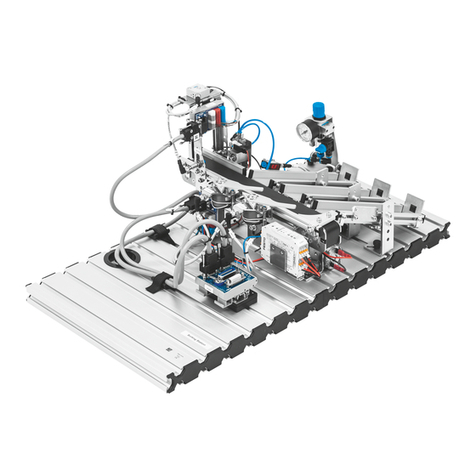
Festo
Festo MPS 8046325 User manual
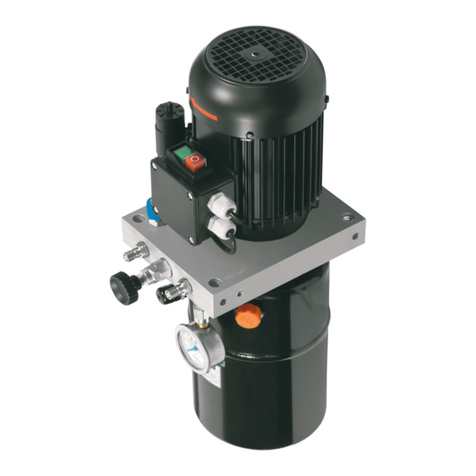
Festo
Festo 152962 User manual
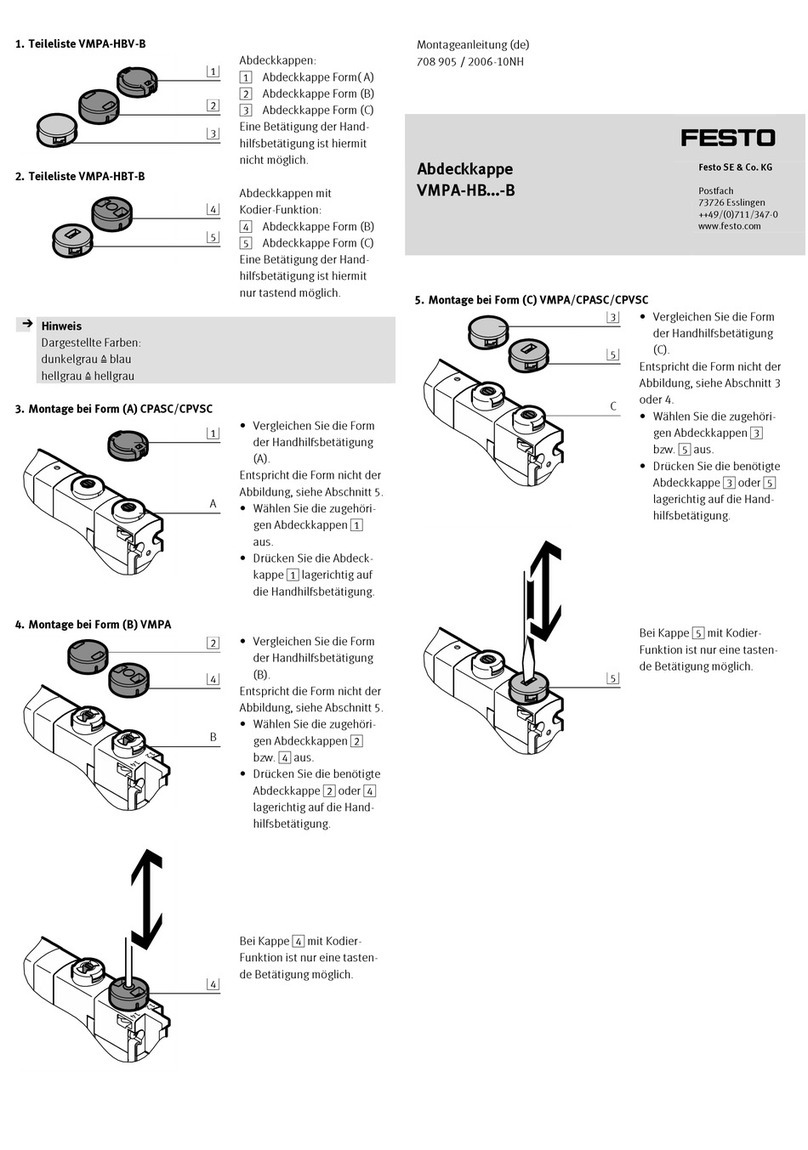
Festo
Festo VMPA-HB B Series User manual
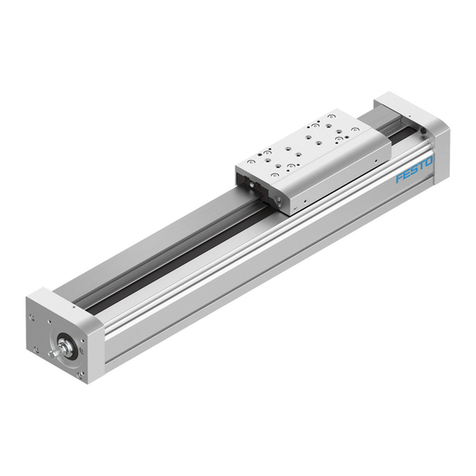
Festo
Festo EGC Series User manual
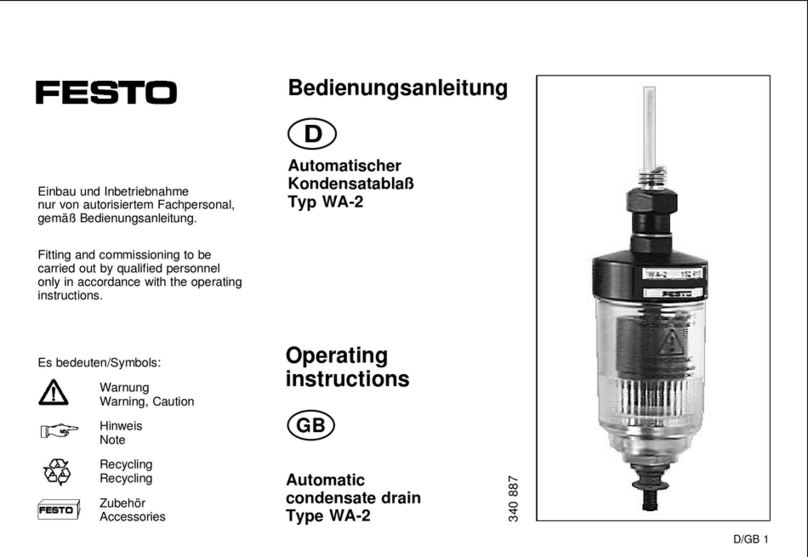
Festo
Festo WA-2 User manual
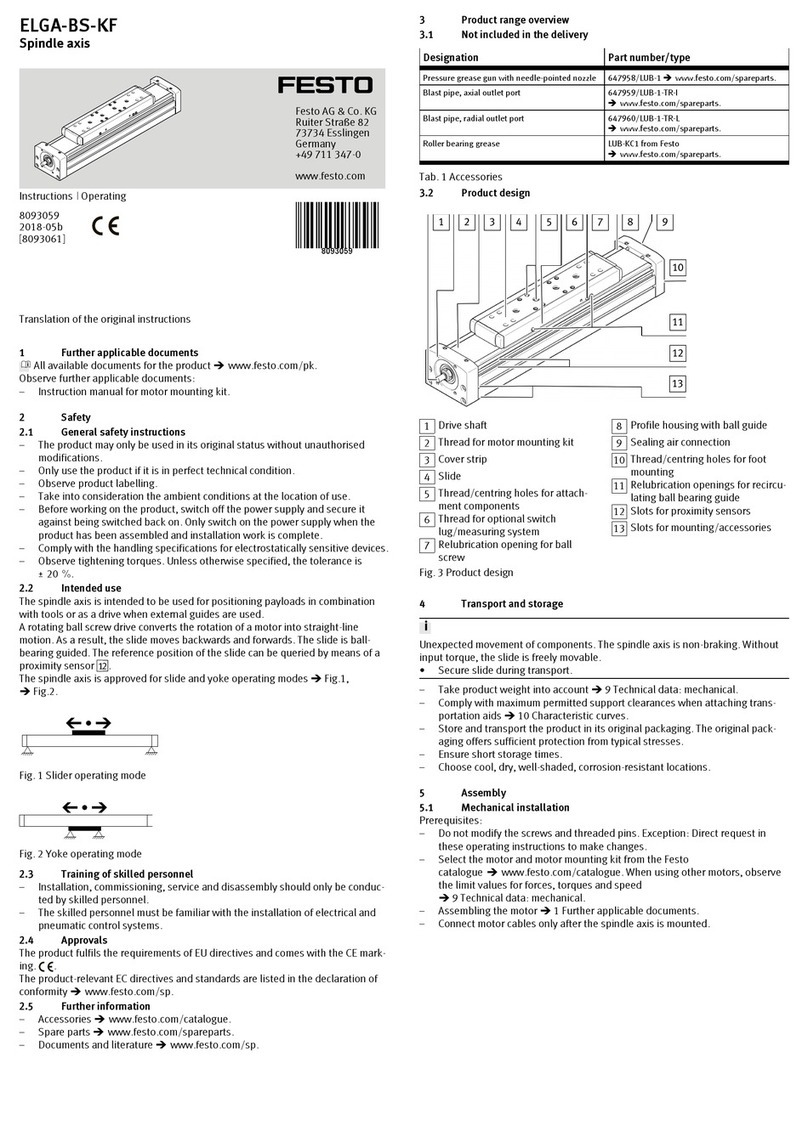
Festo
Festo ELGA-BS-KF-80 User manual
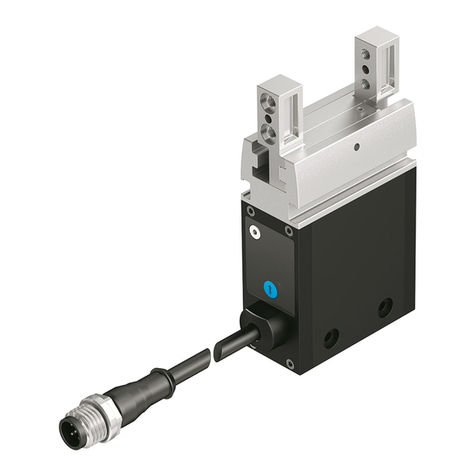
Festo
Festo EHPS LK Series User manual
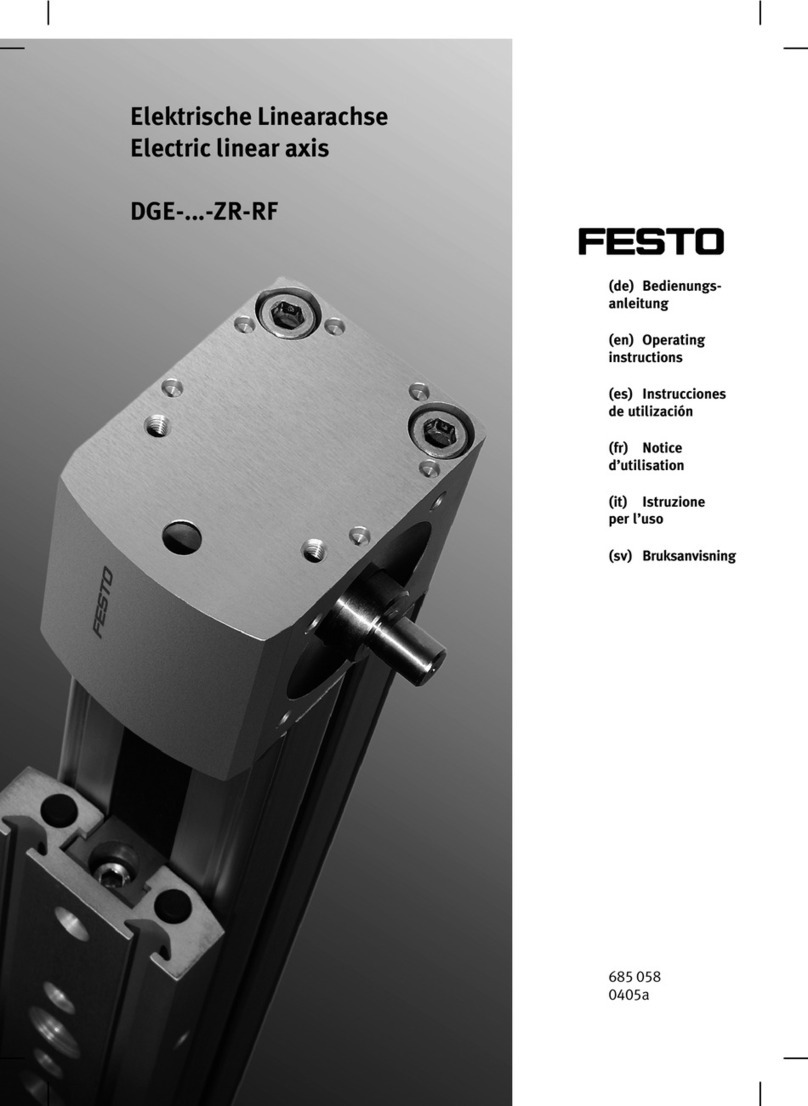
Festo
Festo DGE ZR-RF Series User manual
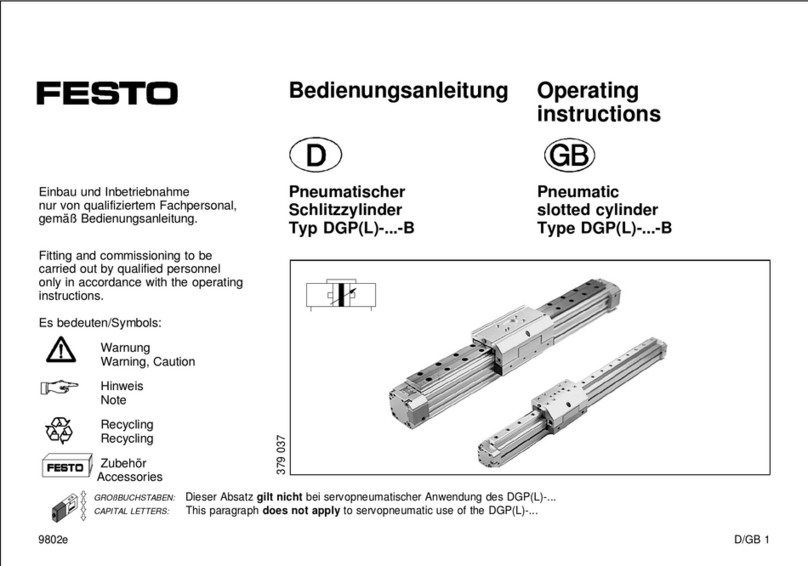
Festo
Festo DGP-B Series User manual

Festo
Festo VTEM User manual
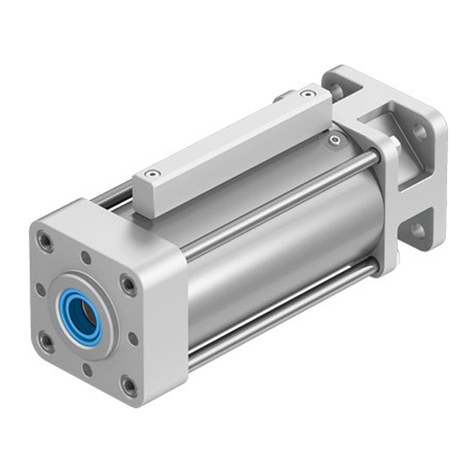
Festo
Festo DACS S Series User manual
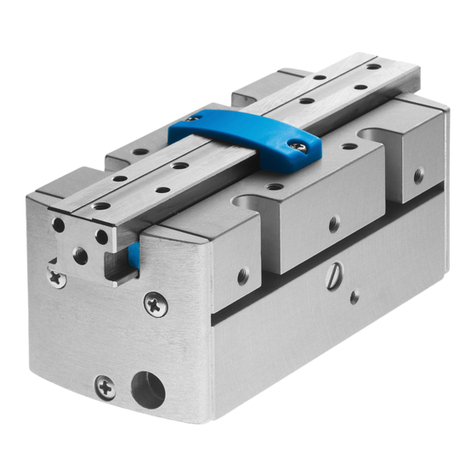
Festo
Festo HGPP A Series User manual

Festo
Festo 696688 User manual
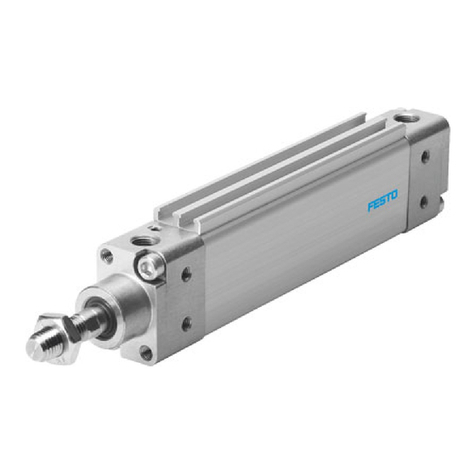
Festo
Festo DZF Setup guide
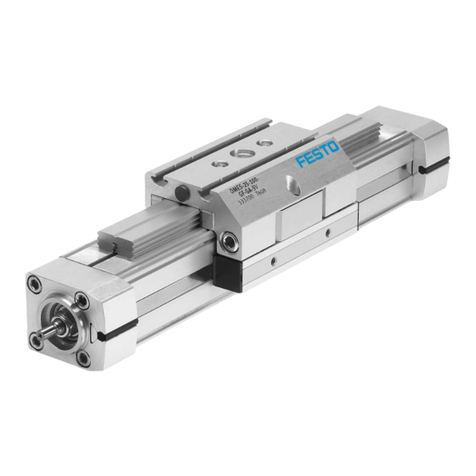
Festo
Festo DMES Series User manual
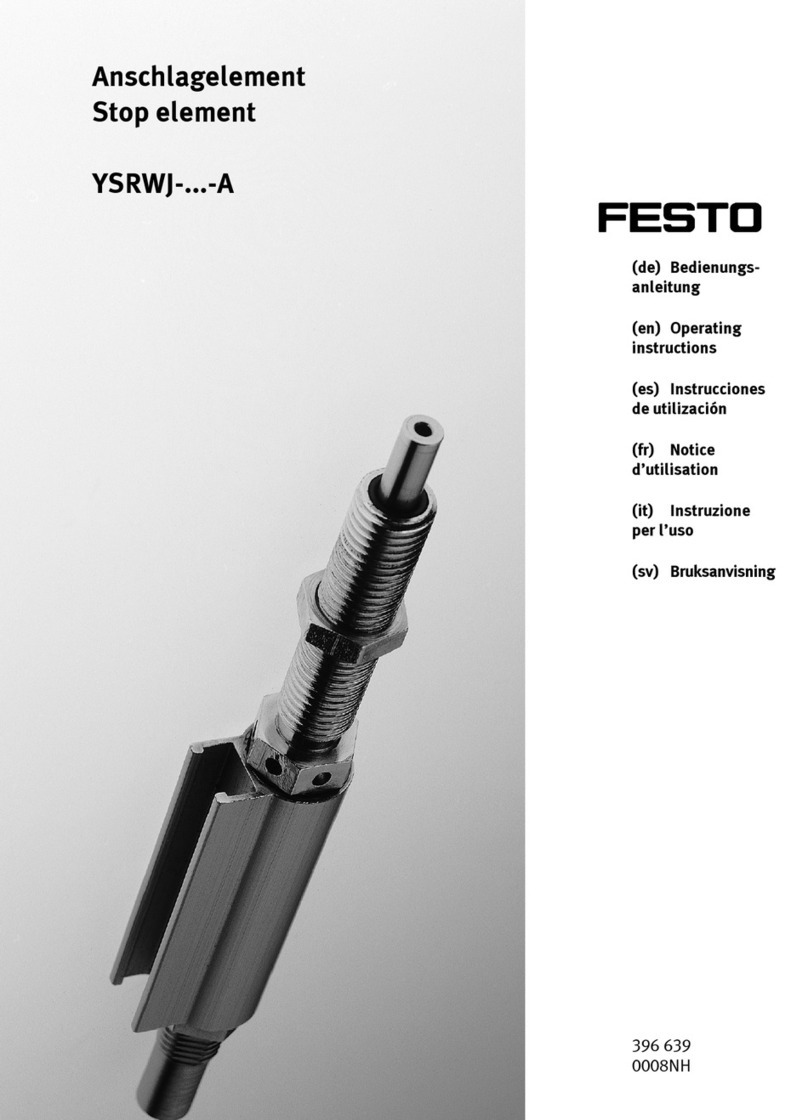
Festo
Festo YSRWJ A Series User manual

Festo
Festo VABM-B10-25EEE User manual
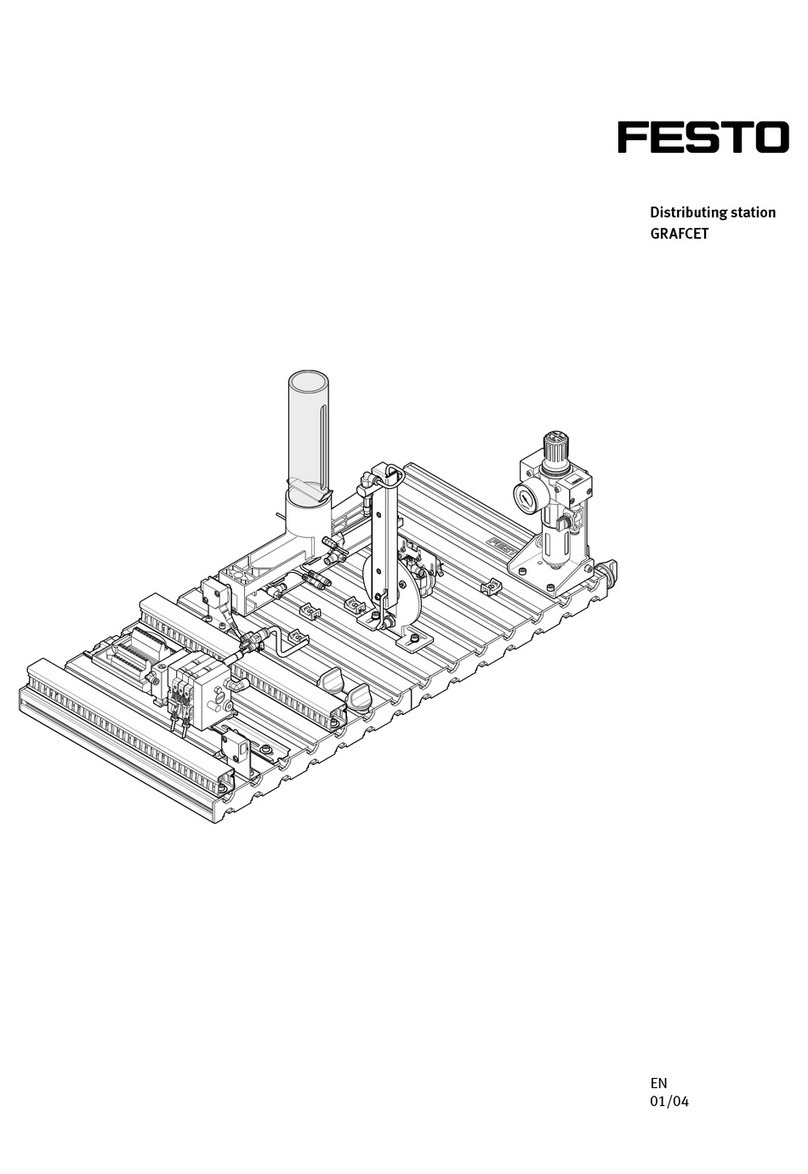
Festo
Festo Distributing Station User manual
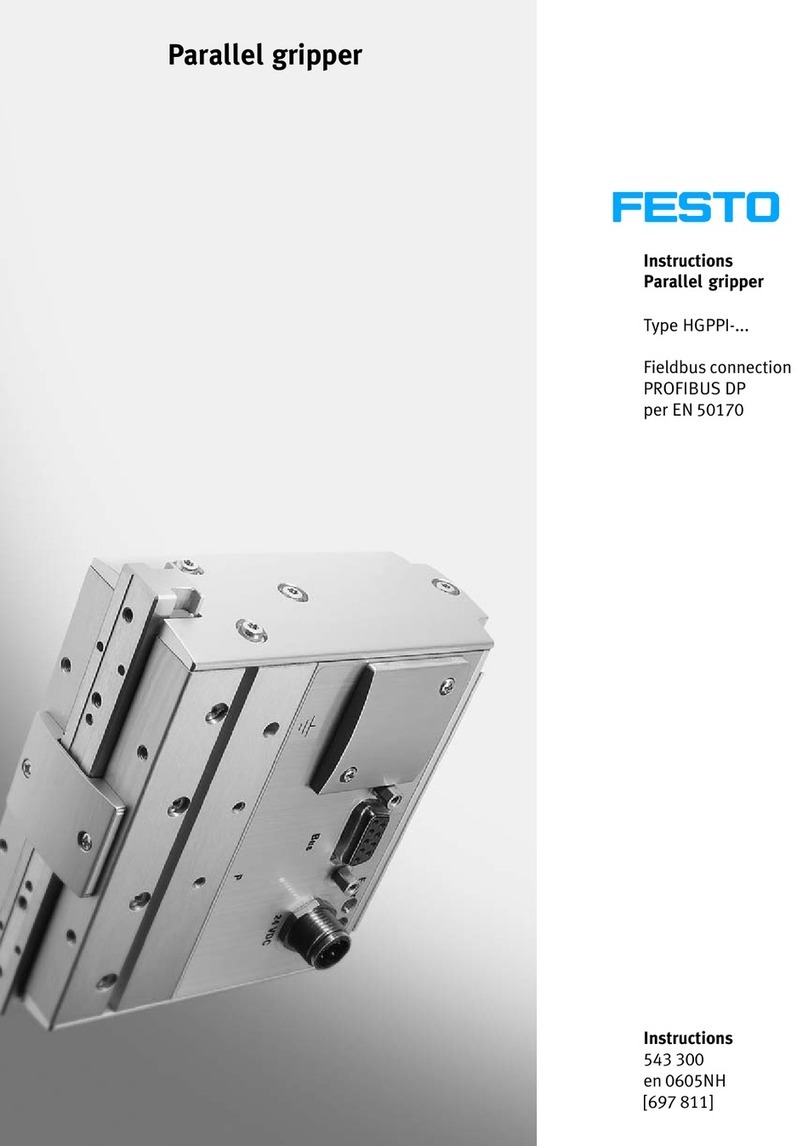
Festo
Festo HGPPI Series User manual
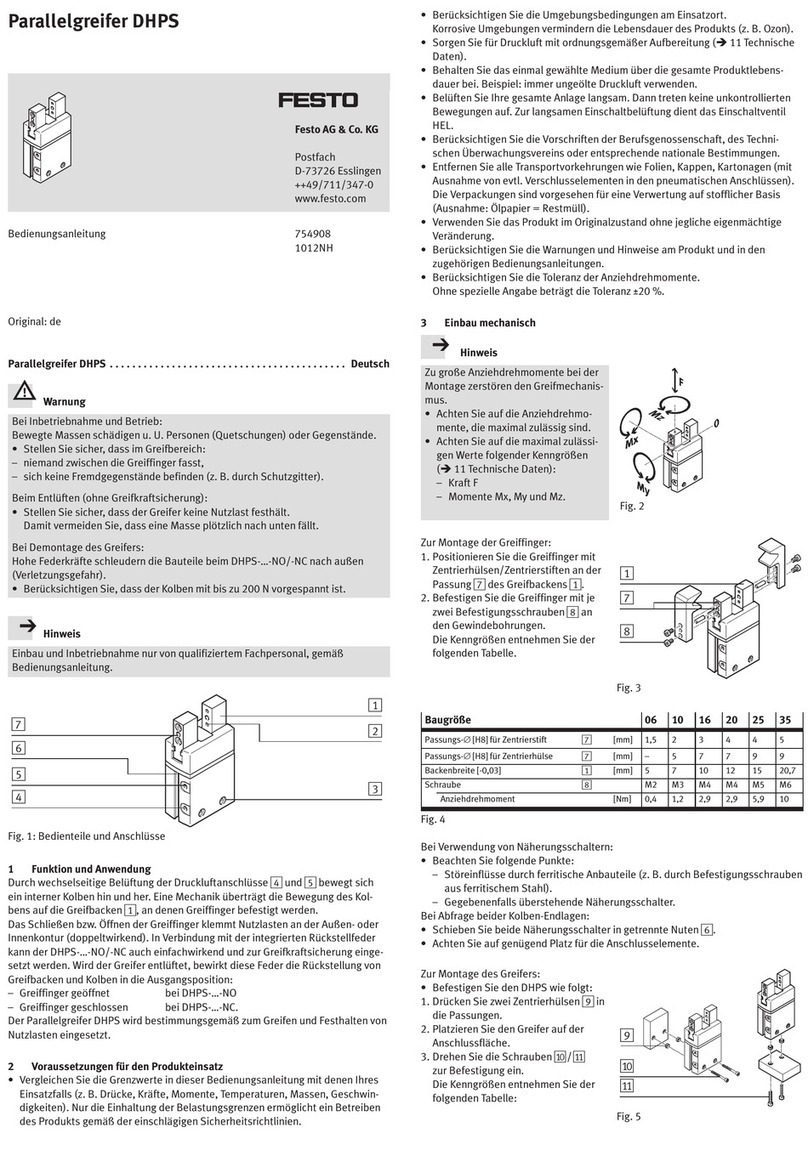
Festo
Festo DHPS User manual
